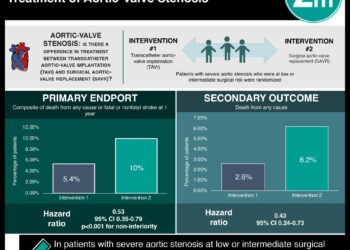#VisualAbstract: The Portico aortic valve shows non-inferiority to commercially available valves (PORTICO IDE)
1. The Portico aortic valve had non-inferior rates of all-cause mortality and disabling stroke at 1 year after randomization compared to commercially available valves.
2. The Portico aortic valve had a higher rate of all-cause mortality and serious adverse events than commercially available valves 30 days after randomization.
Evidence Rating Level: 1 (Excellent)
Study Rundown: In patients with aortic stenosis for whom open heart surgery has unfavorable risks, transcatheter valve replacement is considered the standard of care. Although three such valve systems are currently commercially approved by the US Food and Drug Administration, no self-expanding, flexible valve system that preserves coronary access for future treatment exists. This study (PORTICO IDE) was the first randomized controlled trial to compare the safety and efficacy of the novel self-expanding intra-annular Portico aortic valve system with that of three commercially available valves (the SAPIEN 3, Evolut R and Evolut PRO systems) among high and extreme risk patients with aortic stenosis. The Portico valve showed non-inferiority to commercial valves in the study’s primary efficacy endpoint, 1-year all-cause mortality or stroke, but was associated with higher rates of mortality and vascular, thrombotic, hemorrhagic or end-organ damage-related complications at 30 days, the trial’s primary safety endpoint. A major limitation of this study was that, due to its length, several improvements of the commercial valve systems have been released, affecting the applicability of the results. Other limitations include combining both balloon-expandable and supra-annular valve systems, each with a unique safety profile, within the control group, as well as limited experience with the Portico valve potentially causing increased safety events in some centers. To summarize, the Portico valve proved non-inferior for 1-year all-cause mortality, but was associated with higher all-cause mortality and a worse safety profile at 30 days follow-up compared to conventional commercial valve systems in the as-treated population. These findings suggest that, given its comparable efficacy but poorer safety profile, use of the first-generation Portico valve system is generally not favorable until improvements are made.
Click to read the study in The Lancet
Relevant Reading: Transcatheter Aortic-Valve Replacement With a Self-Expanding Valve in Low-Risk Patients
In-Depth [randomized controlled trial]: This multicenter, randomized, controlled, non-inferiority study was conducted to compare the safety and efficacy of the novel, first generation self-expanding intra-annular Portico transcatheter aortic valve system with commercially available valve systems. Adults with high and extreme open heart surgical risk (chance of mortality post-operation > 15% & 50% at 30 days, respectively) with severe aortic stenosis (aortic valve area <1.0m2 and mean transvalvular pressure gradient > 40mmHg or jet velocity > 4.0m/s or doppler velocity index < 0.25) were recruited, and randomly assigned to either the Portico (n=381) or commercial valve group (n=727). Of the total population, 521 (69.5%) had an average frailty index > 2, 541 (72.1%) an NYHA class of III or IV, and 133 (17.7%) were extreme surgical risk. There were two primary endpoints, the safety endpoint being a non-hierarchical composite of all-cause mortality at 30 days after randomization, and the efficacy endpoint being a non-hierarchical composite of all-cause mortality and disabling stroke at 1 year after randomization. The Portico valve showed non-inferiority to commercial valves with its primary efficacy endpoint (14.8% vs. 13.4%, respectively; absolute difference 1.5%, 95% confidence intervals [CI] -3.6 to 6.5; upper confidence bound [UCB] 5.7%; p(non-inferiority) = 0.0058), as well as non-inferior rates of safety events at 30 days (13.8% vs. 9.6%, respectively; absolute difference 4.2%; 95% CI -0.4 to 8.8; UCB 8.1%; p(non-inferiority) = 0.034). Of note, post-hoc superiority tests showed that the Portico valve was inferior compared to valve systems for the primary safety endpoint (absolute difference 5.0%, 95% UCB 8.9%; p=0.037). When comparing valve types individually, mortality at 2 years was higher for the Portico valve compared with the SAPIEN 3 valve, but similar between the Portico and Evolut R/ Evolut PRO valves.
©2020 2 Minute Medicine, Inc. All rights reserved. No works may be reproduced without expressed written consent from 2 Minute Medicine, Inc. Inquire about licensing here. No article should be construed as medical advice and is not intended as such by the authors or by 2 Minute Medicine, Inc.







